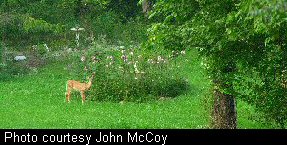

|
Not In My Backyard: The Urband Deer Challenge By Jim Crum
These factors often are not linked, but when combined, they have a synergistic effect on local deer populations. From 1975 to 1991 in West Virginia , forest landholding of 1 to 10 acres, essentially large-lot homesites, increased more than 70 percent. This contributed to a reduction in the number of deer available to traditional hunting. Another factor affecting deer abundance and distribution is the prohibition which restricts shooting a firearm within 500 feet of a dwelling. This removes a minimum of 18 acres from traditional firearms deer hunting for each house, reducing the effectiveness of hunting to control the deer population. A third factor is the homeowner who alters nature's system of checks and balances by feeding deer. This worsens the situation by creating an artificial deer abundance through both behavior modification and fawn production. Interactions between deer and humans ultimately determine the public tolerance level toward deer. “Cultural carrying capacity” is a term often used to describe this maximum number of deer that can coexist with humans. This number is not a function of nature but of human perceptions, values, and preferences. Looking at West Virginia , it is not surprising that contacts between humans and deer have increased. Human population density in West Virginia has risen from the early 1900s to a relative stable density of 75 people per square mile. During the same time deer numbers have increased from an estimated low of 1,000 animals in 1910 to a population that supports a sustained harvest of 200,000 deer annually, or 10 deer harvested per square mile of land. West Virginia residents living both inside and outside of incorporated cities and towns have several options in preventing and solving deer-related problems. One management option is to allow nature to take its course. This option does not reduce conflicts with humans and increases the risk of starvation and disease to deer. Another option is to trap and transfer deer to other locations. This option is expensive and there are usually no release sites capable of absorbing large numbers of relocated deer. The option of using fencing and repellents is practical to address site-specific problems but has limited application and is designed to supplement, not replace, deer population management. The use of fertility control agents in urban environments is appealing. However, an effective, safe, low-cost fertility control agent for use on free-ranging deer herds is currently not available. The removal of deer by hired sharpshooters for deer population regulation is exceedingly controversial and expensive. Lastly, the use of regulated public deer hunting is applicable to urban environments but is often under used. Of all the options mentioned above, public hunting is the most efficient and least expensive technique for removing deer. Hunting is frequently ruled out as a deer management option, however, due to perceived incompatibility between hunting and urban environments. In most urban environments hunting is compatible if hunting is customized to avert conflicts, such as restricting the weapon type. In fact, archery hunting has been found to be one of the more compatible types of hunting within urban environments. Shooting a bow is quiet. Bowhunters usually hunt alone, often from a single location, and remain relatively stationary. Archers have been found to be inconspicuous to urban residents and bowhunting is safe for both the hunter and non-hunter.
In West Virginia a special archery deer hunting season is available starting one week prior to the traditional archery season and extending through December 31. To implement the hunt, incorporated cities, towns and homeowner associations must submit a written request to the DNR Director by March 1 of the hunt year. During this special season hunters may take two deer which do not count toward the regular archery season bag limit. Local municipal governments and homeowner associations can customize their hunts with regulations specific for the area, as long as they are within the special archery deer hunting season framework. Hunting zones, hunter proficiency requirements, hunting methods and minimum distances from homes or other dwellings are some examples of customized rules. No injuries have occurred during the eight years urban archery hunts have been held in West Virginia . Ohio DNR established urban deer zones in 1994. These zones include several of the larger metropolitan areas throughout Ohio . Some cities within these zones, in cooperation with the Ohio DNR, allow archery hunting only. In other areas, however, hunters are not limited to archery equipment. The Virginia Department of Game and Inland Fisheries established a special urban deer season in 2002, which has been expanded this year to include January, February and March. Bowhunting as a tool for urban deer population control is not a quick fix for deer problems. Local governments and homeowner associations should implement hunts before severe deer problems arise. Successful deer population control through bowhunting has a higher probability of preventing deer problems before they arise versus fixing the problem after they arise. The number of hunters needed and percentage of huntable land can be optimized the earlier urban deer management is addressed. Jim Crum is a wildlife biologist stationed in Elkins. |
 The first sighting of a deer out the window of a home causes most people to stare in wonder at the detail provided by such a close-up view. Over time, sightings become routine and the wonder changes to intolerance for deer. This change in attitude can be in response to deer damage to ornamental plants, concern for disease, or concern about vehicle collisions with deer. This shift in human response to abundance of deer does not occur overnight and is not caused by a single action, individual, organization, or government agency. It is an accumulation of daily actions over an extended period, involving many factors that invite deer into the backyard.
The first sighting of a deer out the window of a home causes most people to stare in wonder at the detail provided by such a close-up view. Over time, sightings become routine and the wonder changes to intolerance for deer. This change in attitude can be in response to deer damage to ornamental plants, concern for disease, or concern about vehicle collisions with deer. This shift in human response to abundance of deer does not occur overnight and is not caused by a single action, individual, organization, or government agency. It is an accumulation of daily actions over an extended period, involving many factors that invite deer into the backyard.  From a bowhunter perspective, urban deer population control is as much a service as a hunting opportunity because of the urban environment. To encourage more bowhunters to participate in providing this deer population control service, special deer seasons and bag limits have been established in West Virginia and many other states to facilitate the use of hunting as a deer management tool in urban areas.
From a bowhunter perspective, urban deer population control is as much a service as a hunting opportunity because of the urban environment. To encourage more bowhunters to participate in providing this deer population control service, special deer seasons and bag limits have been established in West Virginia and many other states to facilitate the use of hunting as a deer management tool in urban areas.